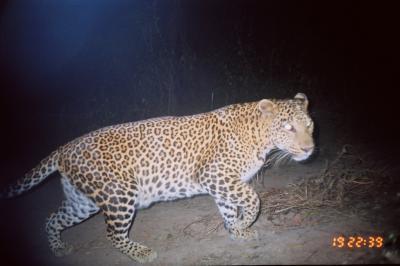What do leopards in India do when prowling at night? Like with smaller domestic cats in America, evidence from a GoPro video around their necks would probably horrify pet owners, but scat samples for leopards in India's Ahmednagar's district in Maharashtra tell the story.
Leopards mostly eat dogs, it turns out.
87 percent of their diet was made up of domestic animals, according to a new study led by the Wildlife Conservation Society. And that was mostly pets dog. 39 percent was man's best friend and 15 percent were even other cats. 17 percent was assorted wild animals including rodents, monkeys, and mongoose, and birds.

Imagine seeing this on your way home from the pub. From a camera trap in India's Ahmednagar's district in Maharashtra. Credit: WCS India
Livestock, despite being more abundant, made up a relatively small portion of the leopard's diet. Domestic goats, for example, are seven times more common than dogs in this landscape, yet only make up 11 percent of leopard's prey.
The author's say this is because goats are less accessible and often brought into pens at night, while dogs are largely allowed to wander freely. Cows, sheep, and pigs were also eaten, but collectively made up less than 20 percent of leopard's food. Most domestic cattle in this region are too large to be preyed on by leopards.
The author's of the study say that the selection of domestic dogs as prey means that the economic impact of predation by leopards on valuable livestock is lower than expected. Thus, human-leopard "conflict" is more likely to be related to people's fears of leopards foraging in the proximity of their houses and the sentimental value of dogs as pets.
Study co-author Ullas Karanth, WCS Director for Science-Asia, said, "During the past two-to-three decades, legal regulation of leopard hunting, increased conservation awareness, and the rising numbers of feral dogs as prey have all led to an increase in leopard numbers outside of nature reserves in agricultural landscapes. While this is good news for conservation and a tribute to the social tolerance of Indian people, it also poses major challenges of managing conflict that occasionally breaks out. Only sound science can help us face this challenge."





Comments